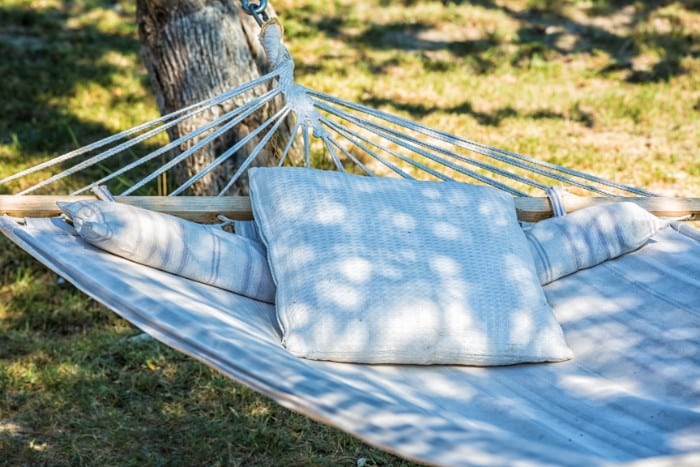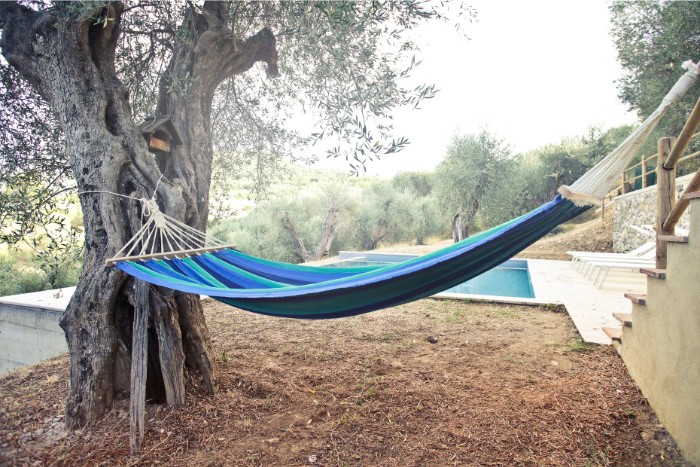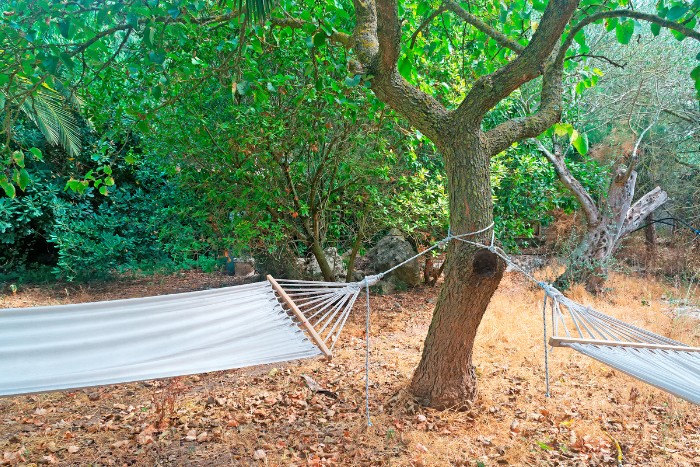You want to skip packing a bulky tent in your backpack, but you aren’t sure how to camp without a tent. A hammock offers a comfortable solution that can keep you off the ground and allow you to enjoy the great outdoors. The question is: how can you comfortably camp in just a hammock?
Hammock camping is easy when you string the hammock with sag and keep the foot end higher. You’ll want to sleep with a pad, a small pillow, and a knee pillow. Be aware of your surroundings and keep your gear off the ground. Protect yourself from moisture with a tarp. Clean your hammock often.
If you’re ready to learn more about successfully camping in a hammock, here is what you need to know.
Tips for Camping in a Hammock
Hammock camping requires an entirely different set of skills from tent camping, but it’s a lot of fun when you’re prepared to do it the right way.
If you’re looking for some reliable hammocks, our guide on the best camping hammocks will help you.
How can you make the most of your hammock camping experience? These tips will help you set the stage for an enjoyable camping experience.
1. Don’t String Too Tightly
One of the most common novice mistakes for hammock camping is stringing up the hammock too tightly.
Instead of stretching it as far as possible and securing it between two trees, you should ensure that it has an adequate amount of sag.
Ideally, it would have a 30-degree sag, making it more comfortable for you to lay in and more difficult to fall out of.
String the hammock too tightly or with very little sag can put undue stress on your body when you try to lay in it.
Instead of allowing you to curl up comfortably, you will find a lot more stress on your shoulders, and your back will curl uncomfortably in the hammock.

2. Keep the Foot End Higher
Many campers mistakenly believe the hammock should be kept level, but this is false. Instead, the foot end of the hammock should be hung about eight to ten inches higher.
This will keep your body from sliding and slumping directly into the middle of the hammock.
If you’re worried about back pain from sleeping in a hammock with little support for your spine, this is one tip that you won’t want to ignore.
3. Remember to Lay Diagonally
Campers often make the mistake of trying to lay horizontally in their hammock, but you should make every effort to lay in it diagonally.
The diagonal placement of your body allows the head and feet to drop while the rest of the hammock supports the torso.
You’ll be surprised at how much more comfortable it is to lay this way. If you cannot lay diagonally in your hammock, it might be time to invest in a longer one.
4. Get the Right Pillow
Some people feel they don’t need a pillow when laying in their hammocks. However, many others find it quite uncomfortable to lie without one. It may take a bit of experimenting to find what works for you.
A small camping pillow can be a great addition to your hammock, but you might want to save space in your backpack for more important items.
If a pillow isn’t right for you, consider bringing a small stuff sack. You can load it up with your extra clothes or a heavy jacket.
Using this for a pillow is a great way to keep your things off the ground and maximize your backpack space for more important gear.
Another thing to remember is that you might need a knee pillow. You can use a rolled blanket or a pile of extra clothes to support your knees’ backside if you’re sleeping in a smaller hammock.

5. Look for a Mosquito Net
Many of the top hammocks on the market come equipped with a built-in bug net. This can keep mosquitos, flies, and other annoying insects off you while you relax or sleep.
Is there anything worse than waking up because you’re uncontrollably itchy from where bugs feasted on you all night?
If your hammock doesn’t have a built-in mosquito or bug net, it’s worth buying one that hangs separately.
Plus, a separate bug net will be a bit roomier if you spend lots of time relaxing in your hammock instead of strictly sleeping in it.
6. Don’t Forget the Sleeping Pad
For many campers, a sleeping pad is designed to keep their body heat from transferring to the cold ground in the middle of the night.
They believe a sleeping pad isn’t needed since they aren’t sleeping on the ground. However, you’ll find that you’re far more comfortable using one in your hammock.
Read our article on the Best Sleeping Pads to buy a good one.
Even when sleeping in a hammock, you compress your sleeping pad underneath you. This allows heat to escape from the bottom of your sleeping pad.
A sleeping pad creates a layer of insulation under you that can keep you warmer and more comfortable.
If you’re struggling to place your sleeping pad right beneath you, squeeze it into your sleeping bag. This way, you won’t be able to move around without bringing your sleeping pad.
We have an article on the Best Sleeping Bags with lots of great options.
7. Consider Bringing a Backup Tent
Campers who have never done hammock camping before might find that they don’t enjoy it as much as they thought they would.
Without practice, getting into your hammock and reclining in it comfortably can be a challenge. If you aren’t sure about hammock camping, it’s best to be prepared for a long night.
Consider bringing a backup tent so you have somewhere to retreat if you can’t get your hammock to hang comfortably in the middle of the night.
You may not need this on future trips as you adjust to laying in your hammock. However, it’s a great option, just in case.
8. Pick Sturdy Trees
It might seem like an obvious tip, but it’s one that many campers neglect to think about. All trees aren’t created equal, especially when supporting your weight using a couple of straps.
You don’t want to end up on the ground in the middle of the night with a tree on top of you. To this end, you need to ensure that you select thick, sturdy trees.
It’s usually recommended that the trees for a single-person hammock be at least six inches in diameter with thick straps to protect the trees from harm.

9. Be Aware of the Surroundings
In addition to choosing the right trees, you must be aware of your surroundings. Look up and ensure that no loose branches dangling above you could fall on you in the middle of the night.
As you move around in your hammock, it will likely move the tree and could knock these branches loose. Even the most seasoned hammock camper sometimes takes a tumble from their hammock.
This is why you should ensure that the ground beneath you is safe to land on. Avoid placing your hammock over ant hills, tree stumps, or anything else that could harm you if you fall out.
10. Don’t Forget to Layer Up
When you sleep in a hammock, you’re surrounded by the air on all sides.
While a sleeping pad and a quilt underneath you can help you stay warm, it’s also important to do what you can regarding your clothing choices.
The best thing to do is to wear many light layers when you go to bed at night.
Make sure that your base layers are made of something warm and breathable to prevent the buildup of moisture.
They should be able to wick moisture away from your skin instead of making the fabric cling to you where it can make you colder.
This tip may not be necessary if you’re going hammock camping in the middle of summer. Spring, fall, and winter will require you to take extra precautions to stay as warm as possible.
Those who don’t want to take precautions could get a cold.
11. Protect Yourself from Moisture
When you camp in a waterproof tent, you rarely worry about how wet you’ll get if it unexpectedly rains.
Hammocks offer no protection from wet weather, so you’ll need to take precautions by hanging a tarp or a rainfly. Some hammocks come with a rainfly to keep you dry in your hammock, but most don’t.
Instead, you can drape a tarp over a guy line over your hammock. Secure the four corners of the tarp with tent stakes to keep it from blowing water in on you in the middle of the night.
It should form an A-frame above your hammock, protecting you from water dripping off the tarp’s edges.
Read our guide on camping in rain and wet-weather for more insights.
12. Stack Your Hammocks
If you and your camping buddies want to camp in your hammocks, you might run into an issue: how many trees are well-suited to hang your hammock?
When trees spaced adequately apart are hard to find, you may have to string more than one hammock from the same trees. How do you go about doing this?
First, you need to ensure that the trees you plan to use are strong enough to support the weight of two or more people.
If they seem relatively small or start to bend when the first person climbs into their hammock, it might not be a good idea to string up another.
Once the trees are strong enough to support you and your friend, you can stack your hammocks on top of the other.
You just have to be mindful about how you climb in and out of the hammock, especially if you’re on top.

13. Keep Gear Off the Ground
Leaving your camping gear on the ground beneath you might not be the wisest idea.
In most camping situations, you would take your backpack and other gear in the tent with you at night to keep unwanted critters from messing with your food stash and other smelly items.
Not to mention, this also keeps your gear from sitting in the dirt, water, and anything else that surrounds your campsite.
Hammock camping means you’ll need extra precautions to keep your gear up. You won’t be able to sleep with your gear in your hammock, so get creative with how you string it up.
Use a carabiner clip to attach gear to an anchor point of your hammock. You can also use a guy line with loops to secure your items above the ground.
14. Take Down Your Hammock
It can be tempting to leave your hammock up when you leave the campsite. After all, it took you a little while to get it set up just the way you wanted it.
You’ll be glad you took it down for that hike. An open hammock is often a trap for curious wildlife who may come to explore the new sights and smells that you brought with you to the campground.
Even if you aren’t worried about wildlife, an empty hammock accumulates leaves and debris from the trees that hang above it.
All you have to do is release the hammock from its carabiner clips. You can leave anchor straps around the trees so that it’s easy to restring later.
15. Don’t Forget to Clean Your Hammock
Especially if you’re an avid camper, you’ll need to clean your hammock after several trips. Sweat and dirt can build up over time and lead to the deterioration of the fabric of your hammock.
The good news is that most hammocks are perfectly safe to be washed in a front-loading washing machine.
You must remove your carabiner clips and toss the hammock on a delicate cycle with some mild detergent.
Remember that you don’t want to dry it in your dryer. Instead, hang it outside on a line to dry.
This means that you’ll need to plan if you want to wash your hammock before your next camping trip so that it’ll be completely dry before you have to pack up.

Final Thoughts
Camping in a hammock can save you some serious space in your backpack if you want to pack as lightly as possible for your next camping trip.
It’s a lot of fun and saves significant time regarding your campsite setup.
Figuring out how to camp in a hammock comfortably is important if you want this to be a lasting experience that you’ll thoroughly enjoy time and time again.
With some of these tips, you’ll be better prepared for your next hammock camping trip!
